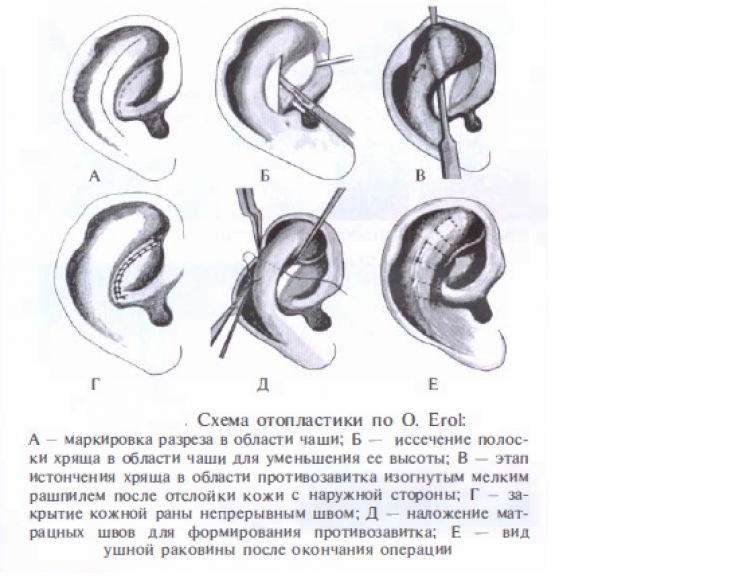Protruding ears, also known as protruding ears, are a common aesthetic defect.
Prominent ears can be caused by factors such as: an increase in the height of the cup with a good development of the antihelix, an underdevelopment of the antihelix, a combination of an increase in the height of the cup and an underdevelopment of the antihelix.
Modern methods of plastic surgery offer a wide variety of techniques for performing surgical correction of ear deformities.
In this article on estet-portal.com you can get acquainted with the correction methods that are used in case of combined deformities of the auricles.
Otoplasty: indications for performance and main tasks of the operation
Indications for otoplasty can be absolute (severe deformity of the auricles) and relative (moderate or mild protruding ears).
When performing otoplasty, the physician should keep the following points in mind:
1. Full face curl of both auricles should be visible due to antihelix;
2. The behind-the-ear recess must not be excessively reduced.
Back in 1968, ACMcDowell outlined the main objectives of otoplasty surgery:
3. Correction of all disturbed proportions, especially the protrusion of the upper part of the auricle;
4. Formation of an even and smooth contour of the antihelix along the entire length;
5. Ensuring the symmetry of both auricles;
6. Auricle overpressure prevention.
It is important to remember that normally the distance from the top of the outer edge of the curl to the skin of the mastoid process is 10-12 mm, the middle part – 16-18 mm and at the bottom – 20-22 mm.

Otoplasty: modern possibilities for correction of protruding ears
There is a wide variety of methods for correcting protruding ears, which can be divided into three large groups.
These include:
1. Fixation of the cartilage of the ear to the periosteum of the mastoid process;
2. Imposition of permanent tightening sutures on the inside of the ear cartilage;
3. Putting incisions on the ear cartilage from its outer side.
Depending on the type of deformity of the auricles, the above methods of surgical correction of protruding ears can be combined with each other.
Follow us on Telegram
Otoplasty is recommended to be performed at the age of 6 years or older, when the formation of the auricles is completed.

Anesthetic management of otoplasty surgery: some features
Before the otoplasty operation, the patient is sedated medically. Local anesthesia is used. Apply a 1% solution of lidocaine with adrenaline at a dilution of 1:200000.
The combination of a local anesthetic and a vasoconstrictor is necessary to facilitate subsequent detachment of the skin from the cartilage island.
This approach also reduces bleeding during surgery.
For more information about modern methods of correcting combined deformities of the auricle, read later in the article.
Earlobe plastic surgery: a simple operation to solve difficult problems
Otoplasty: modern possibilities for correction of combined deformities
Currently, a large number of patients have combined ear deformities. The following methods are used to correct them:
1. Kaue method: from the outside of the auricle in the area of the antihelix and its lateral leg, the skin is exfoliated along with the perichondrium. The cartilage is thinned with a thin curved rasp. This facilitates the subsequent application of fixation sutures. Tightening sutures are applied and an antihelix is formed;
2. Georgiade: combines tightening sutures from the inside of the cartilage and loosening it from the outside;
3. Erol method: through an incision in the region of the upper edge of the cup, a dermal-perichondral flap is mobilized and a falciform cartilage strip is excised. After that, in order to compare the edges of the cartilage at the resection site, sutures are applied. From the same incision, notches are made on the outer surface of the ear cartilage. Stitching up the wound;
Ear correction: ways to correct ear deformities
4. Nachlas method: an incision is made on the posterior surface of the auricle and the cartilage is dissected along the most convex part of the antihelix. The caudal part of the curl is resected. The cartilage is thinned along the edges of the incision with a diamond cutter. The skin is sutured with a continuous skin suture.
For more information about other modern otoplasty techniques, you can read in the article Which shape of the ears do you like more: modern possibilities of otoplasty
Thank you for staying with estet-portal.com. Read other interesting articles in the "Plastic Surgery" section.









Add a comment